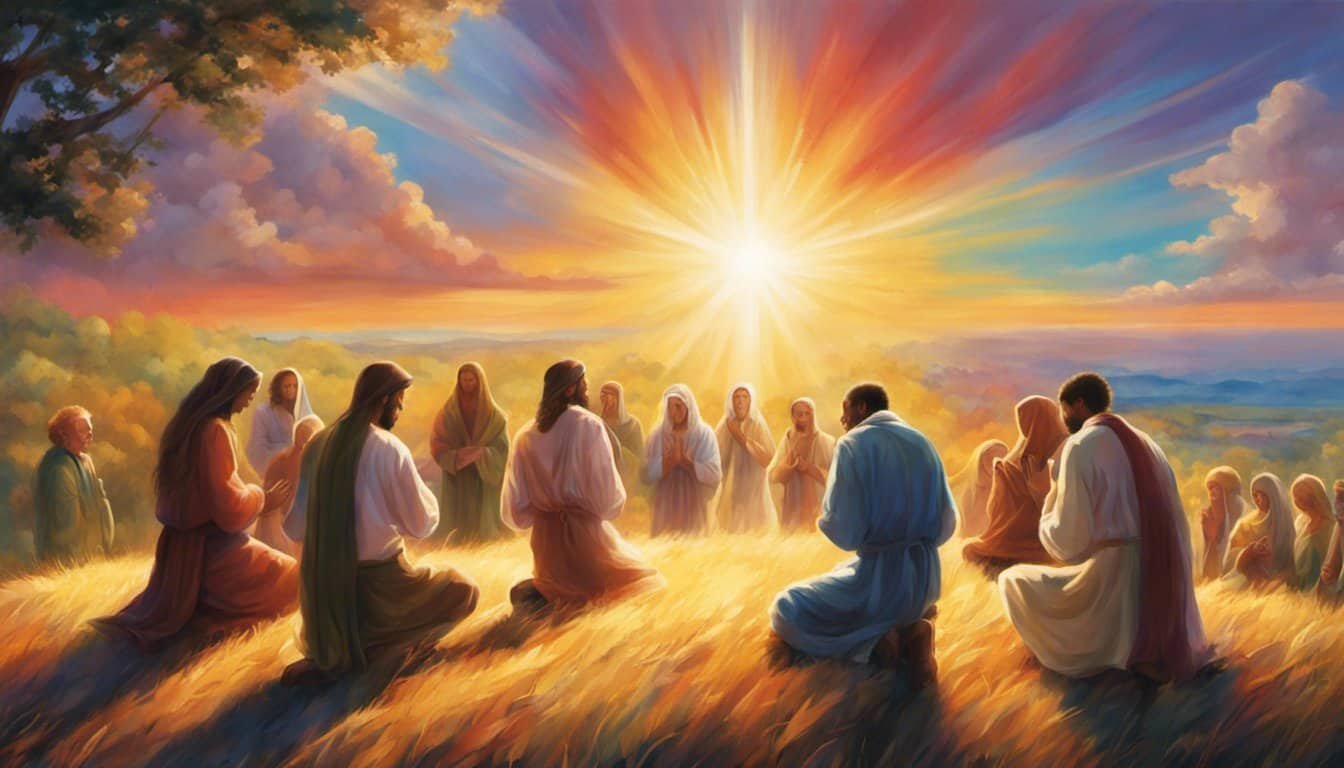Have you ever wondered if the Gospel of John is more like a Christian show than just a historical account? I’ve spent time diving into this question, and it’s fascinating how John’s narrative captivates readers much like a compelling performance. From its unique dialogues to its vivid portrayal of events, the Gospel of John offers a different perspective that’s both engaging and thought-provoking.
In this article, I’ll explore the elements that make the Gospel of John stand out and discuss whether it’s fair to liken it to a “Christian show.” Whether you’re a long-time believer or simply curious, join me as we unravel the layers of one of the most intriguing books of the New Testament.
Overview of The Gospel of John

The Gospel of John stands out among the New Testament books with its distinct approach to telling Jesus’ story. Unlike the Synoptic Gospels—Matthew, Mark, and Luke—it focuses more on the spiritual and theological aspects of Jesus’ life. I find that John’s Gospel delves deep into who Jesus is, emphasizing His divine nature and the profound relationship between Him and His followers.
One key feature is the use of long discourses and dialogues. For example, Jesus’ conversation with Nicodemus in chapter 3 explores the concept of being “born again.” These interactions provide rich insights into His teachings and mission. Additionally, John includes seven miraculous signs, such as turning water into wine and raising Lazarus from the dead, each symbolizing deeper spiritual truths.

The structure of John’s Gospel also differs by organizing events thematically rather than chronologically. This method highlights the significance of each event in revealing Jesus’ identity. Themes like light versus darkness and belief versus unbelief run consistently throughout the text, offering a cohesive understanding of His purpose.
Moreover, John emphasizes the role of the Holy Spirit, referring to Him as the Advocate who will guide believers after Jesus’ departure. This promise adds a layer of comfort and assurance for readers, showing the ongoing presence of divine support.
The Gospel of John provides a unique and profound portrayal of Jesus, focusing on His divine nature, deep theological themes, and the enduring relationship between Him and His followers. This distinctive style contributes to the idea that John’s narrative feels more like a carefully crafted story, engaging readers with its vivid dialogues and meaningful events.
Is The Gospel of John a Christian Show?
You might wonder if the Gospel of John resembles a Christian show. Let’s dive into what that really means.
Defining a Christian Show
A Christian show typically combines storytelling with spiritual lessons to engage and teach its audience. It uses characters, plots, and dialogues to convey messages about faith, morality, and God’s love. Think of how a TV series captivates viewers while delivering meaningful themes. Similarly, the Gospel of John uses narrative techniques to present Jesus’ life and teachings in an engaging way.
Key Elements in The Gospel of John
The Gospel of John stands out with several unique features:
- Distinctive Dialogues: Conversations like Jesus with Nicodemus reveal deep spiritual truths.
- Miraculous Signs: John includes seven specific miracles, each symbolizing a greater spiritual lesson.
- Thematic Organization: Events aren’t listed chronologically but are grouped by their spiritual significance.
- Spiritual Themes: Concepts like light vs. darkness and belief vs. unbelief run consistently throughout the text.
- Role of the Holy Spirit: John emphasizes the Holy Spirit as the Advocate, providing guidance and comfort to believers.
These elements make the Gospel of John not just a historical account but a narrative rich with theological insights, much like a well-crafted show that keeps viewers both entertained and enlightened.
Hey there! I’ve been diving deep into the Gospel of John lately, and a thought struck me: could it be that John crafted his Gospel more like a Christian show than a traditional historical account? Let me walk you through this idea and share some insights from my years as a youth pastor.
Narrative and Theological Themes
You know how a good TV show grips you from the first episode? That’s exactly what John does. Instead of just listing events, he uses vivid dialogues and detailed scenes that pull you right into the story. For instance, Jesus’ conversation with Nicodemus about being “born again” isn’t just a theological point—it’s a dramatic interaction that makes you think.
Practical Tip:
Next time you read John, pay attention to the dialogues. Notice how they reveal deeper truths about Jesus and His mission. It’s like watching a scene unfold, giving you a front-row seat to the conversation.
Deep Theological Themes

John doesn’t shy away from the big stuff. He delves into themes like light versus darkness and belief versus unbelief, making each story a lesson in faith. These aren’t just random topics; they’re carefully woven throughout the Gospel to highlight Jesus’ divine nature and His relationship with us.
Scriptural Insight:
Take John 1:5, for example: “The light shines in the darkness, and the darkness has not overcome it.” This isn’t just a poetic line—it’s a powerful statement about the triumph of good over evil, a recurring theme that resonates throughout the Gospel.
Step-by-Step Tutorial:
- Identify Themes: As you read, jot down recurring themes or symbols.
- Reflect on Their Meaning: Think about how these themes relate to your own faith journey.
- Apply to Life: Consider practical ways to live out these themes in your daily life.
Seven Miraculous Signs as Spiritual Symbols
John includes seven miraculous signs, each loaded with deeper spiritual meanings. These aren’t just miracles for the sake of miracles; they symbolize the transformative power of Jesus in our lives.
Example:
The feeding of the five thousand (John 6:1-14) isn’t just about feeding a crowd. It represents Jesus as the Bread of Life, sustaining us spiritually.
Quick Tip:
When you come across a miracle in John, ask yourself, “What deeper truth is this sign pointing to?” It’ll enrich your understanding and application of the scripture.
The Role of the Holy Spirit
John emphasizes the Holy Spirit as the Advocate who guides believers after Jesus’ departure. This isn’t just comforting; it’s a foundational promise that empowers us to live out our faith.
Inspirational Thought:
Think about how the Holy Spirit works in your life. Whether it’s guiding decisions, providing comfort, or empowering you to serve, recognize the Spirit’s active role in your journey.
Connecting the Dots
Just like a well-crafted show, John’s Gospel is meticulously organized to highlight key messages. Events aren’t presented in strict chronological order but are thematic, allowing each story to build upon the last, revealing more about Jesus’ identity and mission.
Question to Ponder:
How does the thematic organization of John’s Gospel help you understand Jesus better compared to the Synoptic Gospels?
Final Thoughts
Viewing the Gospel of John as a Christian show opens up a fresh perspective. It’s not just a historical account; it’s an engaging, thought-provoking narrative designed to deepen our faith and understanding. So next time you pick up John’s Gospel, treat it like your favorite series—immerse yourself, pay attention to the details, and let the story transform you.

Feel free to share your thoughts or any insights you’ve gained from reading John. Let’s grow together!
Hey there! I’ve been diving deep into the Gospel of John lately, and something struck me—could it be more than just a historical account? Let’s explore the idea that the Gospel of John might resemble a Christian show. Trust me, it’s an interesting perspective that could change how we engage with the text.
Comparison with Contemporary Christian Shows
First off, the Gospel of John isn’t your typical narrative. It’s packed with dialogues, signs, and profound teachings that breathe life into Jesus’ story. Unlike the Synoptic Gospels—Matthew, Mark, and Luke—John focuses on the divine nature of Jesus and His relationship with us. Have you noticed how it dives deep into spiritual themes? Let’s break it down.
Key Features of John’s Gospel
- Long Conversations: Think of Jesus’ talks with Nicodemus or the Samaritan woman. These aren’t just chats; they’re rich with theological insights.
- Miraculous Signs: John highlights seven miraculous events, each symbolizing deeper spiritual truths.
- Thematic Organization: Instead of a straightforward timeline, events are grouped thematically to emphasize their significance.
What Makes a Christian Show?
So, what exactly is a Christian show? It’s a narrative that combines storytelling with spiritual lessons, using characters, plots, and dialogues to convey messages about faith and morality. Think of it as a blend of entertainment and teaching that engages and enlightens its audience.
Elements of a Christian Show
- Engaging Storylines: Captivating plots that keep the audience hooked.
- Relatable Characters: Figures you can connect with on a personal level.
- Moral Lessons: Clear messages about faith, hope, and love.
Similarities Between John’s Gospel and Christian Shows
When you look closely, the Gospel of John shares several elements with contemporary Christian shows. Here’s how:
Engaging Narratives

John’s Gospel isn’t just a list of events; it weaves a compelling story. The dialogues, miracles, and interactions create a dynamic narrative that’s easy to follow and emotionally engaging. It’s like watching a well-crafted series where each episode leaves you wanting more.
Relatable Characters
Jesus interacts with various characters—friends, foes, seekers. These interactions make the story relatable. You see different facets of human emotion and faith, much like characters in a show who face real-life dilemmas and triumphs.
Clear Messages
Every story in John’s Gospel carries a deeper message about belief, love, and eternal life. These themes resonate with viewers, providing not just entertainment but also spiritual nourishment.
Differences That Set John’s Gospel Apart
While there are similarities, John’s Gospel also stands out in unique ways that differentiate it from typical Christian shows.
Depth of Theological Insight
John dives deeper into theological concepts. Conversations about being “born again” or the role of the Holy Spirit aren’t just plot points—they’re profound teachings that invite readers to reflect and grow in their faith.
Symbolism and Themes

The use of light vs. darkness and belief vs. unbelief adds layers of meaning. These recurring themes aren’t just for show; they encourage readers to ponder their own spiritual journeys.
Lack of Chronology
Unlike traditional stories with a clear timeline, John organizes events thematically. This approach highlights the significance of each event in revealing Jesus’ identity and mission.
Unique Aspects of The Gospel of John
John’s Gospel brings something special to the table that you won’t find in other texts or shows.
Seven Miraculous Signs
Each miracle in John’s Gospel isn’t just a display of power; it symbolizes a spiritual truth. These signs invite readers to see beyond the surface and understand the deeper meaning behind Jesus’ actions.
Focus on Divine Identity
John emphasizes Jesus’ divine nature more than any other Gospel. Titles like “Logos” and “I Am” statements reveal His eternal existence and unity with God, offering a unique perspective on His identity.
The Role of the Holy Spirit

John introduces the Holy Spirit as the Advocate who guides believers. This emphasis provides comfort and assurance, highlighting the ongoing presence of God in our lives.
Practical Takeaways for Today
So, what can we learn from viewing the Gospel of John as a Christian show? Here are a few tips to make the most out of this perspective:
Engage with the Narrative
Don’t just read passively. Immerse yourself in the story. Think about the dialogues and signs as parts of a larger narrative that’s meant to teach and inspire.
Reflect on the Themes
Take time to ponder the recurring themes. How do light and darkness play out in your own life? What does belief mean to you personally?
Apply the Lessons
Use the teachings from John’s Gospel in your daily life. Whether it’s love, faith, or understanding the role of the Holy Spirit, find ways to incorporate these lessons into your actions and decisions.
Scriptures to Meditate On

Here are a few scriptures from John’s Gospel that you might find particularly impactful:
- John 3:16:“For God so loved the world that he gave his one and only Son, that whoever believes in him shall not perish but have eternal life.”
- John 8:12:“I am the light of the world. Whoever follows me will never walk in darkness, but will have the light of life.”
- John 14:26:“But the Advocate, the Holy Spirit, whom the Father will send in my name, will teach you all things and will remind you of everything I have said to you.”
Inspiration to Keep Going
Remember, the Gospel of John isn’t just an old book—it’s a living narrative that speaks to us today. By approaching it like a Christian show, we can engage with its stories on a deeper level, finding both entertainment and enlightenment. So, next time you dive into John’s Gospel, think of yourself as a viewer of a divine story, ready to be inspired and transformed.
Impact and Reception
The Gospel of John significantly influences Christian theology and literature. Scholars recognize its unique portrayal of Jesus, emphasizing His divine nature and deep theological insights. Unlike the Synoptic Gospels, John focuses on symbolic language and profound discourses, which have shaped Christian thought for centuries.
Early church fathers, such as Augustine and Athanasius, highlighted John’s theological depth, reinforcing the concept of Jesus as the Logos. Their interpretations established foundational doctrines like the Trinity and the incarnation. This theological emphasis has permeated various denominations, fostering a unified understanding of Jesus’ divinity.
In modern times, the Gospel of John attracts diverse interpretations. Contemporary theologians appreciate its literary artistry and spiritual richness. Academic studies often explore its themes of light, life, and belief, providing a framework for ethical and moral discussions. These explorations contribute to ongoing theological debates and personal faith journeys.

The cultural impact of John’s Gospel extends beyond theology. Literature, art, and music draw inspiration from its narratives and symbols. Iconic artworks, such as Leonardo da Vinci’s “The Last Supper,” reflect John’s influence on visual storytelling. Musical compositions and hymns incorporate its themes, enhancing worship experiences and spiritual reflection.
Public reception of the Gospel of John remains robust. Bible studies and religious education programs prioritize it for its accessible yet profound messages. Faith communities use its passages to inspire sermons, group discussions, and personal meditation. The Gospel’s ability to resonate with both believers and seekers underscores its enduring relevance and transformative power.
| Aspect | Impact |
|---|---|
| Theological | Defines Jesus as the Logos, influences doctrines like the Trinity |
| Literary | Enhances narrative storytelling with symbolic language |
| Cultural | Inspires art, music, and literature |
| Educational | Central to Bible studies and religious education |
| Public Reception | Maintains widespread relevance in faith communities and personal faith |
John’s Gospel continues to shape Christian identity and practice. Its reception across different eras and cultures highlights its universal appeal and deep spiritual resonance. By bridging historical context with contemporary faith, the Gospel of John remains a cornerstone of Christian belief and expression.
Conclusion
Seeing the Gospel of John as a Christian show really opened my eyes to its unique storytelling. The vivid dialogues and powerful themes make it engaging and meaningful, just like a great show. I find myself more drawn to its deep spiritual lessons and the way it highlights Jesus’ divine nature. This perspective helps me connect with the text in a fresh and exciting way. It’s amazing how John’s Gospel blends entertainment with profound insights, making it a timeless resource for faith and reflection. Exploring it this way has truly enriched my understanding and appreciation of the beautiful narrative it presents.












